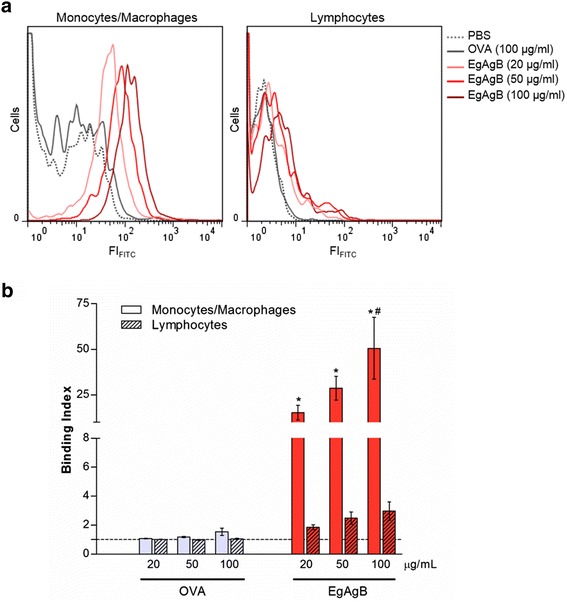Fig. 1.

Binding of native EgAgB to mouse inflammatory cells. Binding of native EgAgB to mouse inflammatory cells was evaluated using peritoneal inflammatory cells and biotinylated EgAgB (20, 50 and 100 μg/mL). Biotinylated OVA was used as a control. Protein binding was detected by incubation with an excess concentration of streptavidin-FITC. Macrophages and monocytes were selected by co-staining with anti-F4/80 antibody conjugated to phycoerythrin. Lymphocytes were identified on the basis of their size (FSC), complexity (SSC) and negative stain for F4/80. a Histograms with the distribution of cell population as function of FITC fluorescence for controls (grey) and EgAgB-treated cells (red). Histograms are representative of three independent experiments for monocytes/macrophages (F4/80+) and lymphocytes (F4/80−). b EgAgB binding to monocytes/macrophages or lymphocytes are shown as binding index (increment of the fluorescence relative to the control with BB), corresponding to the mean values ± SEM of three independent experiments. Binding of OVA (grey) and native EgAgB (red) is shown for monocytes/macrophages (empty bars) and for lymphocytes (filled bars). Asterisks (*) denote significant differences with respect to the control (one way ANOVA followed by Dunnett’s post-test, p < 0.05), while number signs (#) denotes significant differences when comparing the binding to monocytes/macrophage to that to lymphocytes (one-way ANOVA analysis, followed by Tukey’s post-test (p < 0.05)
